In this article you will find 17 hands-on activities for critical thinking to help children develop cognitive skills in a fun and engaging way.
As parents, our child’s wellbeing is our main goal in the parenthood journey. Any parent will tell you that they want their child to be happy and healthy. And indeed this is the most important, but I would add that I want my child to be happy and healthy as an adult as well.
So in order to see your child become a happy adult, you must help him become a smart child first. I thought of 17 critical thinking games for kids that you can use to boost your child’s intelligence from an early age.
For more activities that focus on cognitive skills, read how to develop thinking skills activities.
This post may contain affiliate links and I may earn a small commission when you click on the links at no additional cost to you. As an Amazon Affiliate, I earn from qualifying purchases. You can read my full disclosure here.
Fun Critical Thinking Games for Kids
The activities below work best in pairs or small/large groups and are suitable for older children (7-15 year-olds), but there are variations (activities 4, 7, 10, 13, 14) that could be played by young children too (3-6 year-olds). It is never too early to start using activities that shape your child’s critical thinking skills and help you raise a smart child.
- Are you questioning me?
- Take a seat
- Read my mind
- Picture story
- Password game
- Solve the mystery
- Spot the differences
- Abstract pictures
- Jumbled words
- Listen to the sounds
- Making groups
- Rub out and replace
- Sentence starters
- Slow reveal
- Disappearing text
- Three picture story
- What has just happened
1. Are you questioning me?
a. Divide the players into pairs. Give each pair some pictures, either of people doing different activities or you can choose an illustrated story.
b.One member from each team will hold the picture while the other one turns around so that he cannot see the respective picture and tries to guess the story behind it.
c.The one holding the picture will help his partner by giving clues. “I see a woman and a baby. They are walking.”
d.His teammate will have to try and guess what is in the picture “They are in the park, aren’t they?”
e.His partner can only answer the questions with yes and no. The sooner they guess, the better because they can go on to the next picture.
2. Take a seat
a. Place two chairs at the front of the room
b. Tell the players that one chair represents the truth and the other one a lie
c. Divide the players into two teams and invite two players from different teams to start
e. Read out/utter a statement (simple ones “This is a book” or more complex ones, based on the age of the players)
f. The two players should decide whether the statement is true or false and run to sit on the appropriate chair
g. The quickest to sit down gets one point
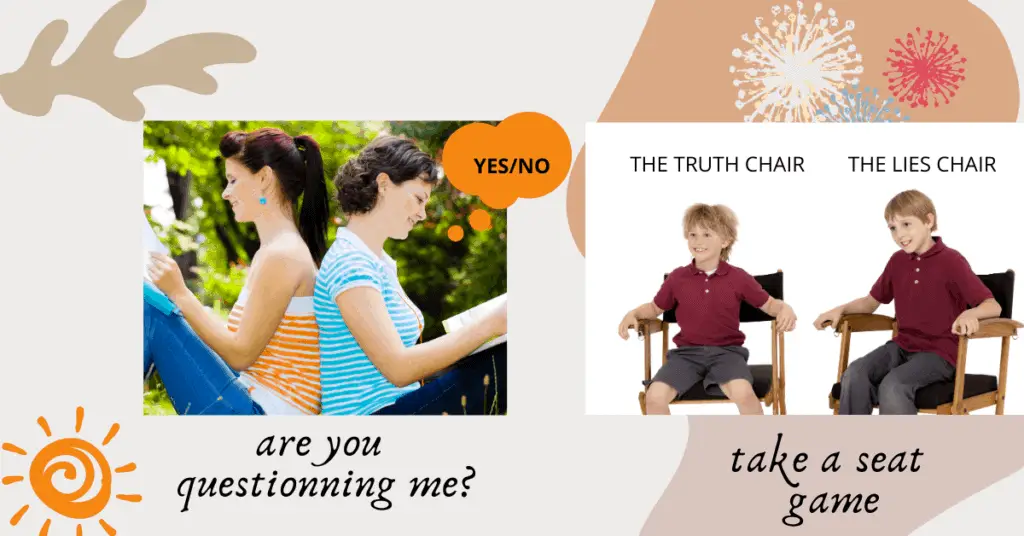
3. Read my mind
a. Choose a set of pictures/flashcards depending on what you wish to revise/teach your child
b. Display the flashcards/pictures on the wall
f. Tell the children that you have chosen a word from the ones displayed and that they have to guess which one it is
g. Invite children to ask questions to guess the pictures; the questions should not include the actual pictures (If there is a flashcard with a cat they cannot ask Is it a cat?)
h. When the children guess, two of the children will become the “runners” and should run to the wall to touch the respective flashcard
For more movement games that you can practice indoors read Indoor Fun Games for Kids.
4. Password game
a. Write on small tickets a variety of words. You can decide on a category and write only words belonging to that category for example.
b. Each person will extract a word from a hat/box/bucket and try to explain it to the other/others without using the word on the ticket.
c. The first to guess it correctly can be the next to extract a word and gets 1 point.
Tip!
For older players: Do not give too many details, give vague descriptions and explanations.
For younger players: Allow miming and sounds alongside verbal descriptions.
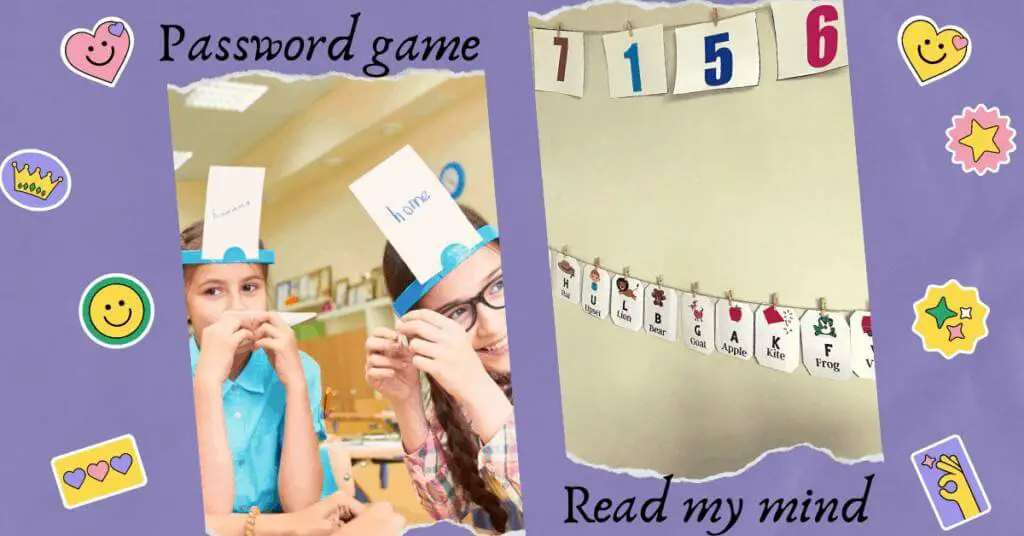
5. Solve the mystery
a. Either print the worksheet you can find here or try to write down your own mysterious story.
c. Include a riddle maybe, a mysterious description of a character, something to distract the reader from the actual answer.
d. Spread clues and pieces of evidence in the room to direct them outside of the room.
e. The answer should be somewhere out of sight, far from the place where the action started.
Tip!
For older players: Act out the story.
For younger players: Offer all clues in the form of riddles.
 6. Picture story
6. Picture story
a. Tell children to draw a story. Allow for plenty of time to draw important scenes from the story. NO WRITING!
c. Separate drawings, either draw each scene on a separate piece of paper or cut the story out into smaller drawings
d. Mix all drawings and give them to your partner.
e. Your partner should order the pictures and try to tell the story by using all the details of the drawings.
Tip!
You can also include numbers alongside drawings to finish faster or to add a little bit of confusion.
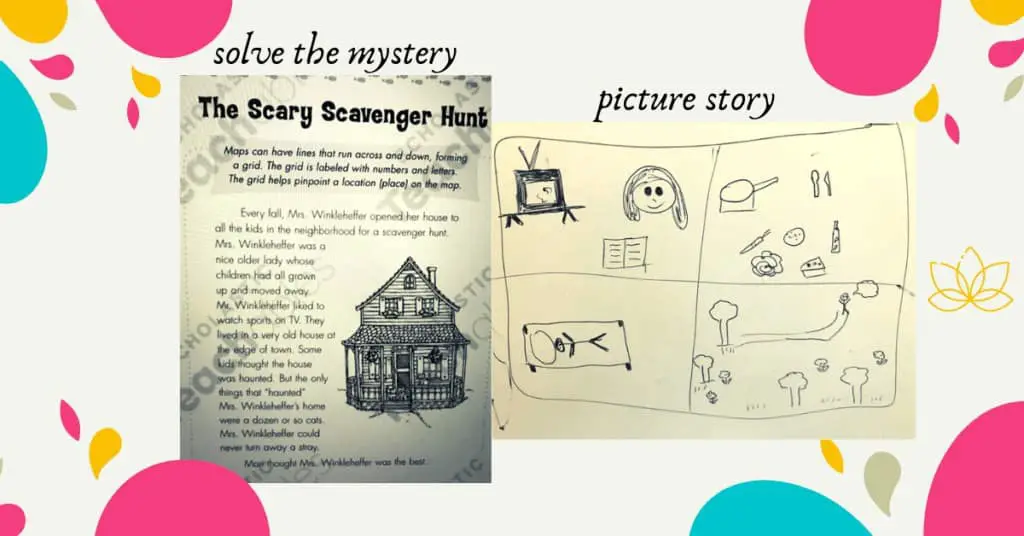
7. Spot the differences
a. Invite one player/one team to go out of the room.
b. Move objects around the room and change their initial place.
c. When the players come inside, they must spot all the objects that have been moved and try to put them back.
d. Swap places and repeat the procedure.
8. Picture game
a. Draw a small part of a picture.
b. Ask the players to guess what it is going to be. Encourage different opinions.
c. Continue drawing, adding details bit by bit.
e. Build the picture up in about four stages, after each stage stop and invite players to justify their opinions.
Tip!
Draw an abstract picture and encourage players to tell you what they see and give details.
9. Jumbled words
a. Write down words that are difficult to spell.
b. Write the letters in jumbled order.
c. Choose a specific category to encourage players to concentrate on words belonging to that category.
d. Set a time limit and let players discover the words, either in pairs of individually.
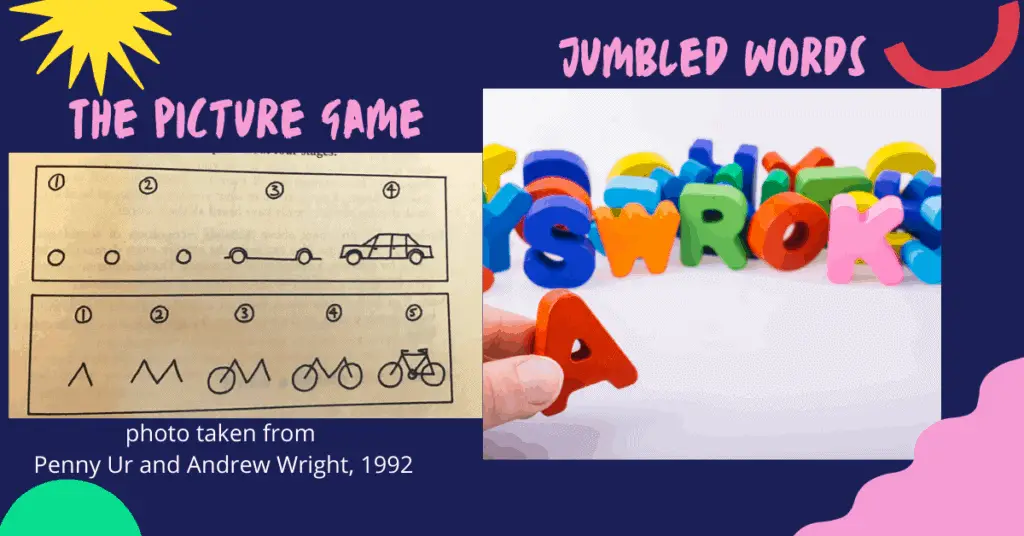
You can also try all our amazing activities for teaching letters in a fun way in the article The Best Activities for Teaching Letters to Toddlers.
10. Listen to the sounds
a. Either play recordings on your phone or mime the sounds yourselves.
b. Players must guess what/who made the sound
c. Another option would be to
d. The player can guess the character/describe the scene
Tip!
For older players: play a music video/a scene from a TV show/series and have the player turn around so that he cannot see, but only listen and guess
For younger players: play only animal sounds, sounds in nature (wind, water, birds etc) or favourite cartoon characters
11. Making groups
a. Choose a specific category of words/ideas that you wish to choose. (opposites, synonyms, even/odd numbers, environmental issues, transportation, toys etc.)
b. Write down words related to the category chosen in pairs/teams/individually
c. Players should group words from the list and explain why the words were grouped like that (eg. transportation: according to number of wheels, speed)
Tip!
For younger players: use pictures and teach them to sort according to size, material, colour, shape etc
For older players: introduce abstract concepts (beauty, empathy, poverty) through the use of pictures and have them think of similarities/differences and discuss why and how the pictures share features.
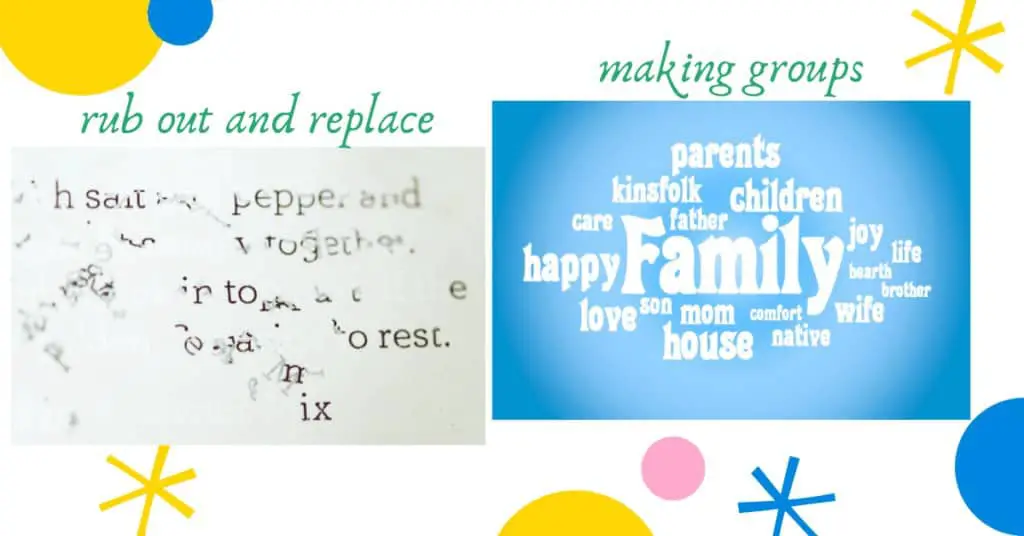
12. Rub out and replace
a. Choose/create a piece of writing.
b. Print it and choose large font/write it down on a whiteboard
d. In pairs/groups have the players think of some substitution words to be used in the text (maybe set a limit of ten words).
e. Rub out the words suggested by the players and replace them in the text
f. Read the text again, now with the words replaced
g. Discuss the differences between the original and the present texts. Are they even similar now?
13. Sentence starter
a. Give the players a word/two/three words to start a sentence (eg. Friendship is…)
b. Each player can then continue the sentence as he wishes
c. Write down all the ideas and have each player think of one more/two more sentences to make all the sentences feel more like a poem
d. Read out loud all poems
14. Slow reveal
a. Choose flashcards/large pictures of various objects/famous people/book covers etc
b. Use an envelope and place one picture/flashcard inside the envelope
c. Slowly extract the picture from the envelope, revealing it little by little
d. Reveal only a little bit and ask the players to guess what they see
e. Once again reveal a little bit more and invite guesses
Tip!
Invite players to manipulate the materials and do the revealing bit.

15. Disappearing text
a. Read and discuss a short text/poem
b. After some minutes of discussion, erase two/three sentences from the text (the beginning or end, sentences should be connected)
c. Invite players to write from memory the missing words in the sentences which were erased.
e. Discuss which example was closest to the original text
f. Repeat the procedure until all original text has been replaced
16. Three-picture story
a. Choose three large pictures (from magazines, comics etc)
b. The first one should show some people in a setting
c. The next pictures should ideally portray an event, object, situation
d. Show the first picture and encourage players to call out anything they want to say about the picture.
e. Collect all suggestions and together decide on a beginning for the story.
f. Gradually add to the story and invite players to think of an ending in pairs
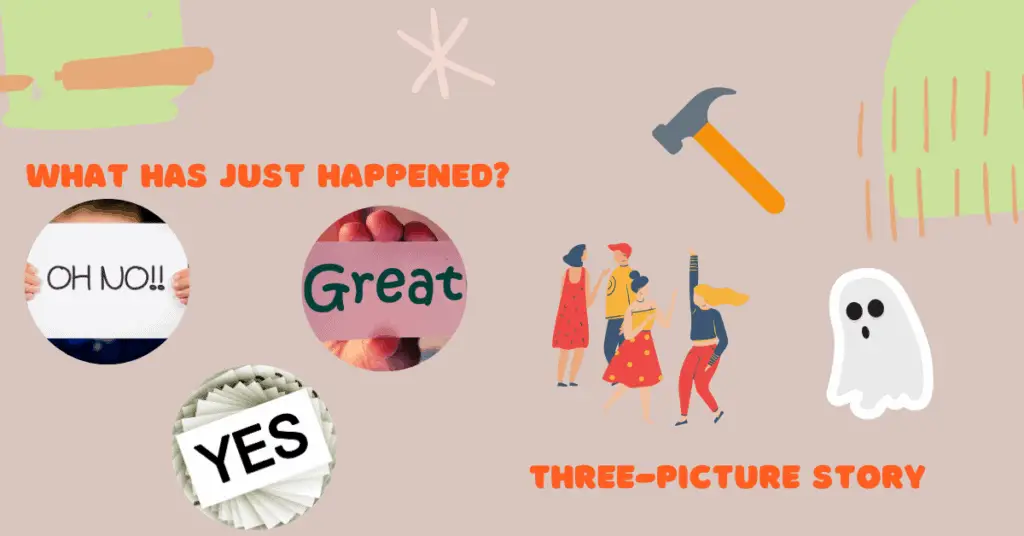
17. What has just happened
a. Write down a series of exclamations (Yes!!. Oh no! Great! Never mind! Etc)
b. In pairs, players choose one exclamation from the ones written and think of an event that caused a person to say such a thing
c. Players could invent a short dialogue and act it out/describe the event in detail
d. Choose another exclamation and repeat the procedure
Conclusions
We are happy to bring you activities that can help you raise a smart child and shape his future. We addressed visual-spatial learners as well so if you need activities for your little ones, make sure to read our article dedicated to visual-spatial learning.
We have chosen the particular activities above because they address critical thinking and reasoning skills, essential for the future.
We are now raising kids for an unknown future, which is evolving extremely quickly and the best tools to equip them with are rational and logical thinking.
To raise a smart child and boost his intelligence is to prepare a child for any kind of future.
“Since the jobs that our preschoolers will do probably don’t exist yet, our priority is to teach them the skills to adapt and inquire and question and cooperate…life skills. So much more useful than rigid concepts” ~ Caroline Bellouse
We share all of our ideas on our Facebook group Learning Activities for Kids.
The form you have selected does not exist.

Hi. I am Monica, an experienced ESL teacher and early years student, mother to a preschooler and passionate reader.

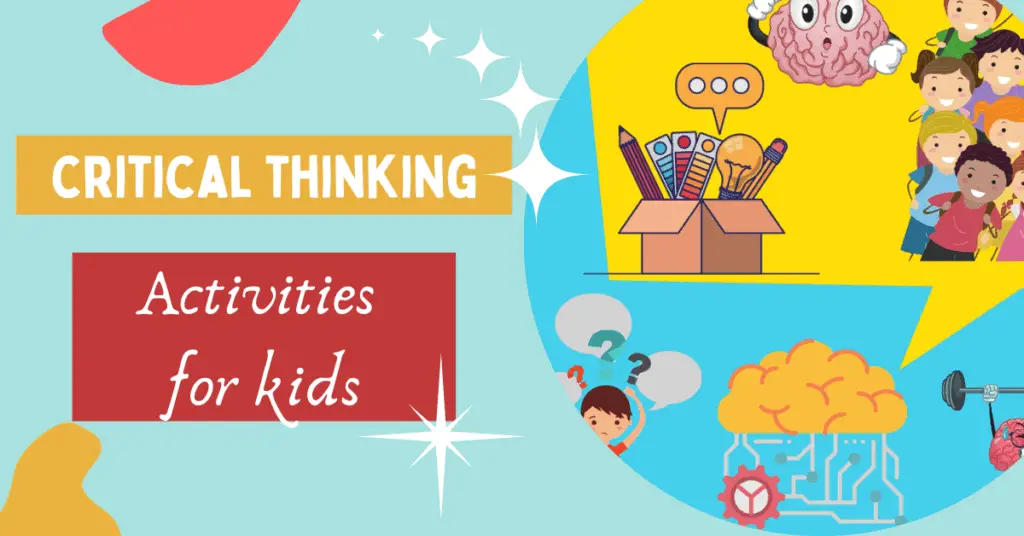
These are great activities to try but I don’t like the premise that “smart kids” do it. Plenty of kids are smart but may not have some of these skills. Still great list of activities.
What a fun list of ideas! My kids already love to do things like #7, #9, and #13 on their own, so will have to try some of the others, too. We sometimes do a variation on #13 at dinner/on long car trips where we all take turns adding a few words to “write” a story together – it’s fun to see how it evolves!
Great blog post! So many great activities to do with children to keep them occupied and learn at the same time!
Learning is so different for everyone. It is nice to know what works well, especially in hard times like these.
Great post! I love all the different ideas, I’m always looking for new ways to keep my kiddos busy.
The list is very full of games that facilitate learning, but also lots of fun. Parents can use this guide to help reduce screen time.
Thank you for this! I’ll try this to my niece. I bet she’d enjoy the activities.
What a great list of learning games to play with my kids. Thanks for taking the time to put this together with instructions for each game!
I love learning, I am a firm believer that one should never stop learning. So I want to set up my kids in such a way that they love to learn…and continue their pursuit of learning constantly. Raising a child with activities like the one you mentioned are great ways to raise a smart child.
I just love this! Having just graduated with my masters in early childhood education – this makes my heart happy! I love how you really delve into all things making up the psychological side of a tiny human and how it can be used to shape their minds! Great post!